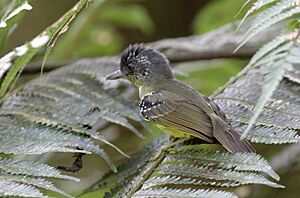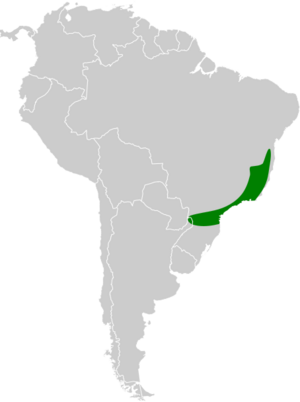Spot-breasted antvireo facts for kids
Quick facts for kids Spot-breasted antvireo |
|
|---|---|
 |
|
| Male - southeast Brazil | |
| Conservation status | |
| Scientific classification | |
| Genus: |
Dysithamnus
|
| Species: |
stictothorax
|
 |
|
The spot-breasted antvireo (Dysithamnus stictothorax) is a small bird found only in Brazil. It gets its name from the cool spots on its chest! This bird is part of a group called "typical antbirds." Scientists have listed it as a Near Threatened species. This means it needs our help to protect its home and make sure it thrives.
Contents
About Its Name
A Dutch scientist named Coenraad Jacob Temminck first described the spot-breasted antvireo in 1823. He gave it a scientific name, Myothera strictothorax. The name stictothorax comes from ancient Greek words. Stiktos means "spotted" and thōrax means "breastplate" or "chest." So, its name literally means "spotted chest"!
Today, this bird is placed in the Dysithamnus group. A German bird expert, Jean Cabanis, created this group in 1847. The spot-breasted antvireo is the only bird of its kind, meaning it's a unique species without different types or subspecies.
What Does It Look Like?
The spot-breasted antvireo is about 12 cm (4.7 in) long. That's about the size of a small sparrow!
Male birds have a dark gray head and blackish areas around their ears. They also have cool white spots on the sides of their head. Their back is a grayish-olive color. They have a hidden white patch between their shoulders. Their wings are dark, with wide reddish-brown edges on the flight feathers. The tips of their wing feathers are white. Their tail is a reddish-olive color with thin white tips.
The male's throat and upper chest are white. The rest of their belly is mostly yellowish. Their chest has large dark spots, which is how they got their name! The sides of their body look a bit grayish.
Female birds look a little different. They have a reddish-brown crown on their head. Their back and wings are more olive and less gray than the males'. Females do not have the white patch between their shoulders. They also have fewer spots on their chest than the males do.
Where It Lives and Its Home
The spot-breasted antvireo lives along the coast of southeastern Brazil. You can find it from southeastern Bahia all the way south to Santa Catarina. It also lives a bit inland in Minas Gerais. Some people thought it lived in Argentina, but bird experts have not found any records of it there.
This bird makes its home in evergreen forests. It likes to live in the lower parts of the forest, from near the ground to the middle branches. It especially likes the edges of the forest, like along roads or around natural open areas. You can find it from sea level up to about 1,250 m (4,100 ft) high in the mountains.
Behavior
Movement
Scientists believe the spot-breasted antvireo stays in the same area all year round. It does not migrate to other places.
What It Eats
The spot-breasted antvireo mainly eats insects. It also enjoys other small bugs like arthropods. Sometimes, it will even eat berries from Rapanea mistletoe plants.
This bird usually hunts for food alone or with one other bird. It often joins groups of different bird species that are feeding together. It typically looks for food from near the ground up to about 10 m (33 ft) high in the trees. It's a very active and agile feeder. It usually picks prey off leaves, vines, stems, and small branches while perched. It might stretch or hang upside down to grab its meal. Sometimes, it even makes short flights to catch bugs in the air.
Reproduction
Scientists have found and photographed one active spot-breasted antvireo nest. It was discovered in November and had a baby bird inside! The nest was a small cup shape. It was hanging from a fork in a tree branch about 15 m (50 ft) above the ground.
Sounds It Makes
The song of the spot-breasted antvireo is a "hurried series" of about 20 soft, slightly choppy notes. The song goes up and down in pitch, and the last few notes get faster. Its calls include a short, rising "chirr" sound. It also makes a nasal "qwark" sound and a series of three notes where the first two are the same pitch.
Status and Protection
The IUCN (International Union for Conservation of Nature) has listed the spot-breasted antvireo as Near Threatened. This means it's not in immediate danger, but it could become so if we don't protect it.
This bird lives in a small area, and we don't know exactly how many there are. However, experts believe its population is shrinking. The biggest threats to this bird are cities growing, new factories, farms expanding, and more roads being built.
Even though it's threatened, the spot-breasted antvireo is still fairly common in most places it lives. It can be found in some protected areas. It also seems to do well in forests where some trees have been cut down. However, the area where it lives has lost a lot of its natural forest. Because of this, scientists need to keep a close eye on this bird and other species that live only in this region.


